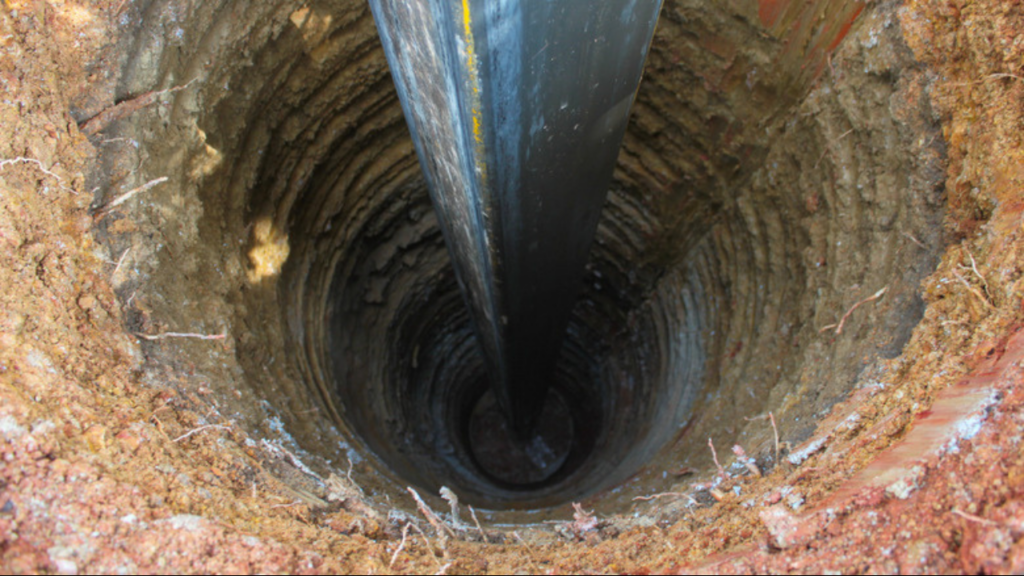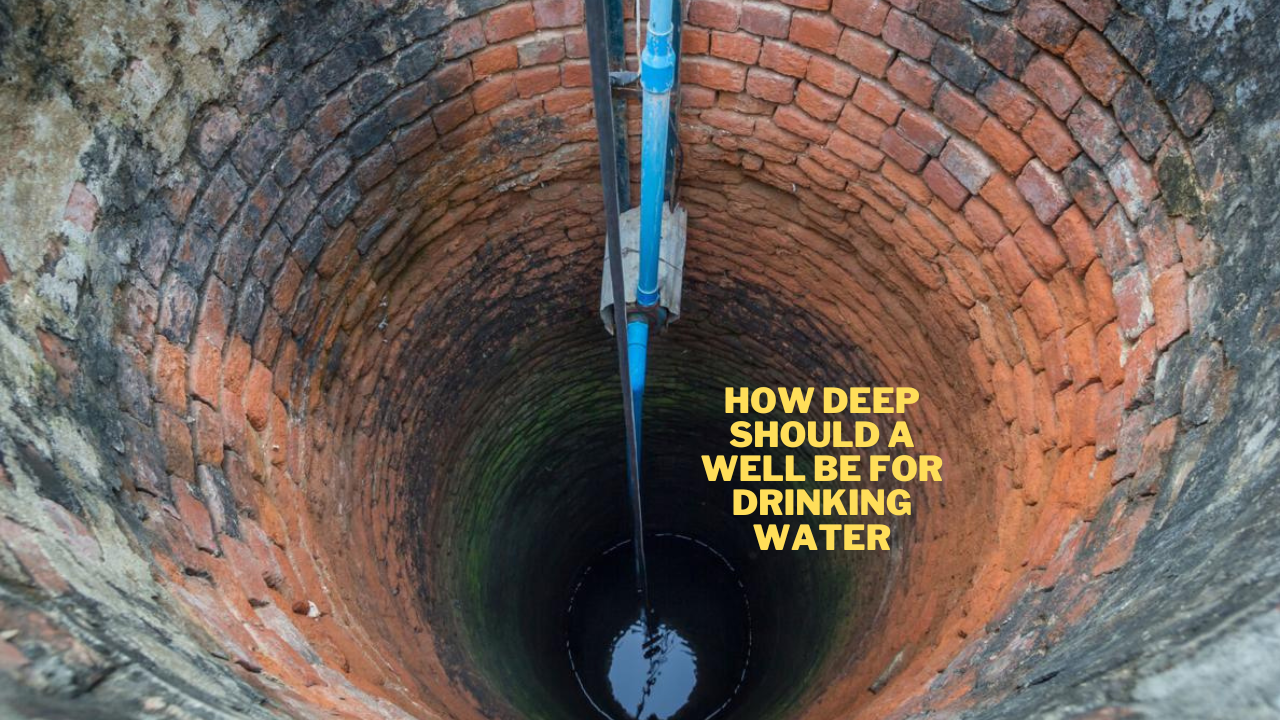The depth of a well is an important consideration when it comes to guaranteeing a trustworthy and safe source of drinking water. A drinking water well’s depth influences how successfully it protects the water from the pollutants. The typical depth of a domestic well in the United States is between 100 to 800 feet.. However, it is important to understand that “How Deep Should a Well Be For Drinking Water” is a complicated concern that is impacted by the influence of multiple factors, one of which is the subsurface water levels in the area.
Important Points To Take Note:
- It is recommended that you dig a well at least 100 feet below the surface of the ground, or 10 feet below the water surface, for an uninterrupted supply of drinking water.
- Certain circumstances may require wells to be deeper—between 300 and 600 feet or more—depending on things like the kind of soil and the laws of the region.
- Consulting with an experienced well driller or hydrogeologist is crucial to determine the most suitable well depth for your particular situation.
- While deeper wells can be more costly to construct, they offer the advantage of delivering cleaner water with reduced susceptibility to contamination from agricultural pesticides and surface pollutants.
Where Does Water From Wells Come From?
The majority of private well water is sourced from subsurface reservoirs. This water is typically found in the saturation zone, created as rain and snowmelt infiltrate the ground and accumulate within the gaps between rocks. For most shallow wells, this saturation zone serves as their primary water source.
The numerous subterranean aquifers beneath the water table are accessible through deeper wells.
A well needs to be sunk to a depth that will provide a steady supply of water and reduce the possibility of pollution in order for it to operate properly.
Why Does The Well Depth Matter?
A well that we dug for drinking water needs to be sufficiently deep. The reason why we keep a well deep is to prevent the surface impurities from getting into the water. Keep in mind that it is important to dig a well deeply to make sure that the water we drink remains pure and safe. As a natural barrier, the well’s depth prevents impurities and pollutants from getting to the water source.
Ideal Well Depth For Drinking Water
A drinking water well should ideally be between 80 and 120 feet deep. This depth range offers a layer of protection against potential surface pollutants that are close to the surface of the ground. However, the exact optimal depth for a well may vary according to the geographical area.
Factors To Consider Before Choosing Well Depth
There are many things that you should think about for Well Depth before choosing the right well depth for your drinking water.
The factors that might affect the depth of a drinking water well are given below;
The Area Around Your Well
It’s an important factor to consider whether the place around your well is clean and appropriate. If it’s tidy, the depth of the well does not need to be extremely deep. However, if there are dirty areas nearby, like where animals are kept, then it is safer to have a deeper well to make sure your water is clean.
Risks of Dirty Water
Wells that are deeper are less likely to have dirty or contaminated water. If you build your well with casing and caps, it will have the ability to keep out stuff like mud, heavy metals, and tiny living things that can make water dirty. On the other hand, drinking water wells that are not extremely are more likely to be risky. It can have more chances of getting dirty from things like rainwater.
Amount Of Water Under the Ground
It is important to have water underground that can last for many years. The place you select for digging a well should have a huge amount of water since the well has to provide you all the water that you need for your home. Therefore, it is important to have a lot of water under the surface.
High Quality Well Materials
You need to make sure that you use the high quality materials and follow the rules when you build your well. If you do not do that, the water from your well might not be safe to drink.

Steps To Figure Out the Right Depth of Well
To find the best well depth for where you live, you can follow these steps:
Get Information
Start by talking to your state office, well builders, and your neighbours who already have made a well for drinking water. You can also check the previous records online. This will help you learn about the ground where you live and it will also help you to know the exact depth your well should have
Check the Area Around Your Well
Look at the place around your well and make sure it’s clean and safe. If there are dirty places nearby, you might need to build a deeper well.
Think About Dirty Water Risks
Consider if there is a risk of your well getting dirty from things like rainwater or other stuff around.
Measure Underground Water
Find out how much water there is under the ground to make sure there’s plenty of water to fulfil the requirements for your family.
Consider The Water Demand
The volume of water consumption within your household or on your property plays a critical role in determining the optimal depth for your well. In the case of a smaller family, a shallow well may suffice. Conversely, a larger family or substantial water requirements for tasks such as irrigation, livestock care, or maintaining a swimming pool may necessitate a deeper well, drawing from a more abundant and dependable water source.
Furthermore, it is essential to contemplate not only your present water usage but also anticipate future needs. Whether you intend to expand your family, engage in crop cultivation, or increase your livestock, thoughtful planning for these prospective water demands will ensure your well continues to meet your water supply requirements.
Are Deeper Wells More Better For Drinking Water?
The depth of a well has a significant impact on the quality of the water it provides and its reliability. In general, deeper wells usually offer cleaner water and are less likely to run dry. However, it’s essential to acknowledge that this rule may not apply in every situation.
Sometimes, even shallower wells can deliver clean water, depending on your location. Shallow wells, which are closer to the surface, may face challenges like flooding and water shortages, and they are also more prone to contamination.
Nevertheless, it’s crucial to make a thoughtful decision when considering deepening your well. If your local groundwater is already clean, and making the well deeper won’t substantially improve water quality or reliability, you might want to allocate your resources elsewhere.
Balancing your budget wisely, while considering both immediate and long-term benefits, is a crucial decision. Imagine it’s like having a reliable well at your home, providing clean water constantly. To put it simply, choosing a dependable well with clean water is a smart and valuable decision that brings you immediate and lasting advantages, benefiting both you and potential future homeowners.
How To Maintain a Well For Drinking Water?
Maintaining a safe and functional water well extends beyond the initial drilling process. The ongoing protection, preservation, and maintenance of your well require a comprehensive strategy that encompasses several important steps;
Well Siting and Placement
Properly selecting the location of your well is critical. Consider factors such as distance from potential contaminant sources (e.g., septic systems, industrial facilities), geological conditions, and local regulations. The placement of your well can play a significant role in preventing contamination.
Water Quality Monitoring
In addition to regular testing, continuous water quality monitoring systems can be installed to provide real-time data on your well’s water quality. These systems can help you detect sudden changes or trends in water quality, ensuring early response to any issues.
Protective Barriers
Installing protective barriers, such as well caps and grout seals, is essential to safeguard your well against surface water intrusion and the entry of debris, insects, or other contaminants. Ensure that your well cap is tamper-resistant and equipped with a vent to prevent pressure-related issues.
Regular Maintenance Schedule
Develop and follow a well maintenance schedule that includes periodic inspections, cleaning, and equipment checks. Regular maintenance can help identify and address minor issues before they escalate.
Emergency Response Plan
Have an emergency plan in place to address unexpected situations like well contamination incidents. This plan should include procedures for notifying authorities, isolating the well, and providing alternative water sources if needed.
Well Rehabilitation
Over time, wells may experience reduced productivity or water quality issues. Well rehabilitation techniques, such as chemical treatments or well deepening, can be employed to restore your well’s performance.
Community and Regulatory Involvement
Stay informed about local regulations and best practices related to well maintenance and water quality. Engage with local water authorities or well owner associations to exchange information and stay updated on potential threats to your water supply.
Well Abandonment Procedures
If a well is no longer in use or poses a contamination risk, proper abandonment procedures must be followed to prevent it from becoming a conduit for pollutants. Consult with experts to ensure safe well closure.
By following these steps within your strategy for protecting and maintaining your well, you’ll be better equipped to ensure the long-term safety and reliability of your water supply.
Conclusion
Choosing the right well depth is a big deal and depends on where you live. By thinking about the area around your well, the risk of dirty water, how much underground water there is, and using good materials, you can make sure your water stays clean and safe. And don’t forget to test your water every year to keep enjoying clean and safe drinking water for your family. If you need help, ask local experts who know a lot about the land where you live, and that will help your well last and your water stay pure.
